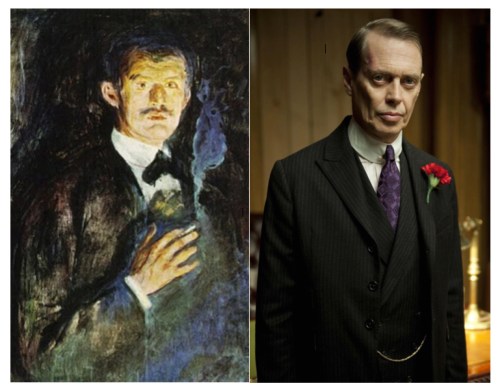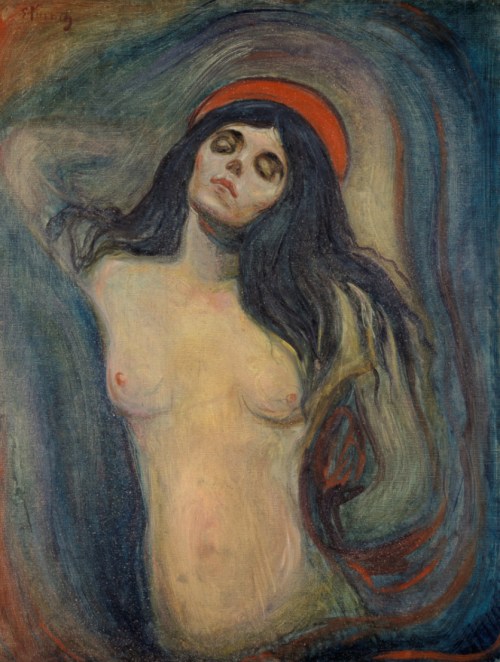By Johna Till Johnson
Last night, some friends and I went to go see the Munch Exhibit at the Met. I’ve been a fan of Edvard Munch since I first saw his work as a teenager in Norway. So when one of my friends mentioned he had never seen the iconic “Scream” in real life, I was delighted to accompany him, his wife, and another friend to the exhibit.
Munch made many versions of his most famous work, including “Scream”, some as wood cuts, others in oil. So although we weren’t lucky enough to see a color version of the piece, we did get to see a black-and-white woodcut.
But while looking through images in preparation for the visit, I noticed something I’d never noticed before.
See if you can see it in the image above… Look towards the horizon… on the water…
Do you see them?
The paddleboarders?
Yes! Quite clearly those are proto-paddleboarders in the background, braving the cold Norwegian waters. All the way back in 1900! Norwegians have always been avant-guard, and Munch was famous for his innovative eye. Apparently he could see into the future!
I pointed this out to my friends when we saw the wood cut. And we all agreed. For sure, those were paddleboarders. Somehow Munch had managed to place a sport that did not yet exist in the center of his most iconic image.
It wasn’t until we compared the image with a photo of the same area that we had to acknowledge they were the masts of small sailboats. But we still preferred our interpretation.
But that wasn’t the end of the surprises that evening. While inspecting Munch’s many self-portraits, I kept having a nagging feeling of familiarity, and not just because I’d seen them before. Hmmm…
Yes, indeed! The resemblance was remarkable! Edvard Munch and Steve Buscemi share not only features but the same intense, haunted stare.
Finally, just because I love it so much, here’s Munch’s Madonna, which is my favorite work of his. Enjoy!







Steve B….one heck of a fine actor. The Scream always made me a bit..squeamish. Paddleboarders?! I never even noticed them!
LikeLiked by 1 person
And now you will never be able to unsee them! Hee hee hee…
LikeLiked by 1 person
haha! I know!
LikeLike
Actually I think they were *big* sail-ships. I remember reading this in Munch’s bio or elsewhere. Some take it to symbolize the modern age, industrialization, etc. His original name for the motive was Der Schrei der Natur (The Scream of Nature).
(Sorry I loser’d out ;-)
LikeLiked by 1 person
Well, if you’d actually SHOWED UP you’d have been able to judge! :-) I don’t know how big they are, perspective can be a tricky thing, but they didn’t look that big in the photo.
Anyway, to me they will always be paddleboarders.
And you really did miss out–not only was Munch excellent, but the “Delerious” exhibit on the adjacent floor totally blew my mind. I am still processing that one!
So if you can make it in the next week or two, I would strongly suggest you go!
LikeLiked by 1 person
He has been compared to Van Gogh
LikeLiked by 1 person
Interesting you should say that, Fletcher!
That was actually the first thing I thought this time around; I don’t know why it didn’t occur to me before then. Definitely a similarity, though I think Van Gogh was more interested in nature, and Munch in people.
Thanks for reading, and posting!
LikeLiked by 2 people
If you go to the vG museum in Amsterdam you will see the similarities
LikeLike
Just pondering: if Munch had lived before Van Gogh, would Vincent have been compared to a “Master” Munch?
LikeLiked by 1 person
I don’t think so… I think there is some cultural clubbiness going on here. Norway was not at that time an “important” country, so by definition anything a Norwegian did would not be as “important” as something done by mainstream Europe.
Kind of the way artistic genius in, say, Native American cultures wasn’t recognized until recently… because by definition “those” people don’t fit the definition of People Who Create Important Art.
Or the way Bob Dylan is an internationally known name and Leonard Cohen less so. Because, you know, Canadian.
It sucks, but that’s how humans operate.
In any event, I’m quite certain that both Munch and Cohen are more than satisfied with the reach and impact of their work. I’d bet more people can recognize and respond to “Scream” than to “Sunflowers” (not to take away from the immense value of either work).
No matter how you slice it, Munch is a Master!
LikeLike
It is so interesting to see the paddleboarders in the background. As you said, back then that wasn’t a sport yet. Maybe it was recognised as a nice way to pass the time back then :)
LikeLiked by 1 person
Can’t tell whether you’re kidding, Mabel, but no, I don’t think paddleboarding existed at all back then. As Runar says, they were probably the masts of tall ships.
But to me, they will always be paddleboarders!
LikeLike
I wasn’t kidding at all! I thought it was a possibility did some rowing. But I have to agree with you – don’t like like ships to me but they look every bit like paddleboarders :)
LikeLike
Paddle boarding has been around for quite along time. Wikipedia quotes that was probably around in Hawaii in the 16th century. In addition there are several other sources online going along those lines. I would wager a guess, Paddle Boarding in some form or another has existed long before that as well, but probably not in Norway., ;)
LikeLike
As a Norwegian I can say with certainty that paddleboards are not part of known Norwegian history. :) That said, humans have always used water for transport, and standing on a piece of floating material – be it one or a bunch of logs being floated down a riveror simply staking oneself from one side of a river or lake to the other. However the cold climate – requiring heavy clothing – and cold and often stormy waters of Norway means that only protective vessels were really usable, i.e. rowboats and larger.
I am reminded here of the mokoro/makoro’s canoes of Botswana, where the operator will stand at the rear, not with a paddle but rather a 3-4 meter straight pole, his standing position allowing him (I am not aware of women operating mokoros) to have good oversight as he steers the mokoro through the Okavango delta’s maze of narrow canals, keeping eyes out for hippos (a major killer in Africa as it can small boats, with ensuing drowning deaths), crocs, etc.
I had the amazing pleasure of trying one out back in 1986. As the makoro operators and my traveling companions were resting after some hours on the water, the operators allowed me to borrow one of their mokoro, and I had maybe 30 minutes to myself roaming around. It was awesome – and probably perfectly ridiculous… Anyway, to show my novice state I managed to break the pole after I got it too deep into the mud and it got stuck while the (heavy) mokoro kept moving forward. If i’d let go of teh pole, all would have been ok, but instead I used my force – and the pole broke…
You can imagine my embarrassment finally making it back to the others, with two 1/2s of a pole. (I do not recall but presumably I used one half of the pole as a “paddle”, so maybe I was the first paddle-boarder in Okavango?!)
The operator was rather embarrassed – and anxious, the mokoro presumably being how he made his living… He explained that the pole was quite expensive and hard to get: the poles are made of the inner core of a special tree, I was told, and is made by slowly buring away the outer layers in order to reach the strong and flexible core… After some negotiation we agreed that the sum of USD10 in cash would be sufficient to cover a new pole. (As a rather lowly paid Peace-Corps volunteer I gladly accepted the fine.)
But back to the Scream. Check out this fascinating detective work to learn more about the painting and the its location. http://www.popspotsnyc.com/the_scream/
LikeLiked by 1 person
PS: here is an example of a row-boat from the western coast of Norway (the gorgeous Hardanger Fiord). You will notice the tall stem, similar to “viking ships”, making the boat better able to withstand high and violent waves and wind, and protecting the passengers and operator(s). And here are some more Norwegian rowboats, https://www.pinterest.com/pin/383791199475746857/?lp=true. And of course, the timber-men, or log-drivers. What amazing skills! Many were killed either by being crushed between the heavy logs, or by drowning in cold rivers! https://en.wikipedia.org/wiki/Log_driving
LikeLiked by 1 person